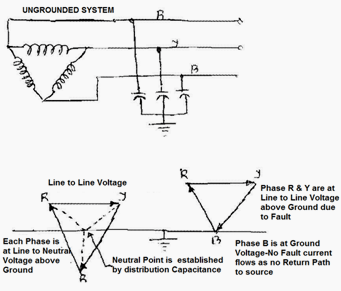Unit - 5
Fault Analysis and Protection Systems
Q1) How do we detect & locate faults in transmission lines, power cables and wiring systems?
A1)
Q2) What are short circuit faults? How are they caused?
A2)
a) These faults may occur because of the internal otherwise external effects
b) Internal effects are transmission lines breakdown, equipment damage, insulation aging, corrosion of insulation within the generator, improper installations of electrical devices, transformers, and their inadequate design.
c) These faults can be occurred because of outside effects of apparatus, insulation failure because of lighting surges & mechanical damage by the public.
Q3) What are open circuit faults? What are their effects?
A3)
a) Open Conductor Fault
b) Two conductors Open Fault
c) Three Conductors Open Fault
a) Electrical power system irregular operation
b) These faults may danger to animals as well as human beings
c) In particular, a portion of the network, when the voltage is exceeded beyond normal values then it causes insulation failures and develops short circuit faults.
d) Even though, these types of circuit faults can be accepted for a long time as compared with short circuit type faults, because these faults must be detached to decrease the high damage.
Q4) Which faults can occur in transmission lines?
A4)
a) Symmetrical faults: In such types of faults, all the phases are short-circuited to each other and often to earth. Such fault is balanced in the sense that the systems remain symmetrical, or we can say the lines displaced by an equal angle (i.e., 120° in three phase line). It is the most severe type of fault involving largest current, but it occurs rarely. For this reason, balanced short- circuit calculation is performed to determine these large currents.

b) Unsymmetrical faults: Unsymmetrical faults involve only one or two phases. In unsymmetrical faults the three phase lines become unbalanced. Such types of faults occur between line-to-ground or between lines. An unsymmetrical series fault is between phases or between phase-to-ground, whereas unsymmetrical shunt fault is an unbalanced in the line impedances.
Q5) State the advantages & disadvantages of ungrounded neutral system.
A5)
After the first ground fault, assuming it remains as a single fault, the circuit may continue in operation, permitting continued production until a convenient shut down for maintenance can be scheduled.
a) The interaction between the faulted system and its distributed capacitance may cause transient over-voltages (several times normal) to appear from line to ground during normal switching of a circuit having a line-to ground fault (short). These over voltages may cause insulation failures at points other than the original fault.
b) A second fault on another phase may occur before the first fault can be cleared. This can result in very high line-to-line fault currents, equipment damage and disruption of both circuits.
c) The cost of equipment damage.
d) Complicate for locating fault(s), involving a tedious process of trial and error: first isolating the correct feeder, then the branch, and finally, the equipment at fault. The result is unnecessarily lengthy and expensive down downtime.
Q6) State the advantages & disadvantages of grounded neutral system.
A6)
The main advantage of solidly earthed systems is low over voltages, which makes the earthing design common at high voltage levels (HV).
a) This system involves all the drawbacks and hazards of high earth fault current: maximum damage and disturbances.
b) There is no service continuity on the faulty feeder.
c) The danger for personnel is high during the fault since the touch voltages created are high.
a) Distributed neutral conductor
b) 3-phase + neutral distribution
c) Use of the neutral conductor as a protective conductor with systematic earthing at each transmission pole
d) Used when the short-circuit power of the source is low
Q7) What do you understand by symmetrical faults?
A7) Symmetrical or Balanced Faults
a) Line – Line – Line Fault (L – L – L Fault): The system remains balanced even after the fault occurs. This type of fault occurs rarely, but when it does occur, it is a harsh kind of fault which holds the largest current, which is used to determine the rating of the Circuit Breaker.
b) Line – Line – Ground Fault (L – L – L – G Fault): This fault comprises of all the 3- phases of the system, and occurs among the ground terminal in addition to the 3-phases of the system. The probability of occurrence of this type of fault is 2-3%.
Q8) What do you understand by unsymmetrical faults?
A8) Unsymmetrical or Unbalanced Faults
a) Line to Ground Faults (L-G): It is the most common fault and 75-80% of faults are of this type, causing the conductor to make contact with the ground.
b) Line to Line Faults (L-L): This occurs when two conductors make contact with each other mainly due to swinging of lines during heavy winds. Only 5- 10% of the faults are of this type.
c) Double Line to Ground Faults (LL-G): Both the two lines touch each other through the ground. There is 10% probability of occurrence of such faults.
Q9) What do you understand by Resistance earthed systems?
A9)
a) To reduce burning and melting effects in faulted electrical equipment like switchgear, transformers, cables, and rotating machines.
b) To reduce mechanical stresses in circuits/Equipments carrying fault currents.
c) To reduce electrical-shock hazards to personnel caused by stray ground fault.
d) To reduce the arc blast or flash hazard.
e) To reduce the momentary line-voltage dip.
f) To secure control of the transient over-voltages while at the same time.
g) To improve the detection of the earth fault in a power system.
Q10) What do you understand by Resonant earthed systems?
A10)

Q11) What are Earthing Transformers?
A11)

Q12) What do you understand by sequence networks of power system?
A12)
Q13) What are solidly neutral grounded systems?
A13)
Q14) What are ungrounded neutral systems?
A14)

Q15) Explain the term ‘Power System Protection’.
A15)
a) Current and voltage transformers to step down the high voltages and currents of the electrical power system to convenient levels for the relays to deal with
b) Protective relays to sense the fault and initiate a trip, or disconnection, order
c) Circuit breakers to open/close the system based on relay and auto recloser commands
d) Batteries to provide power in case of power disconnection in the system
e) Communication channels to allow analysis of current and voltage at remote terminals of a line and to allow remote tripping of equipment.
Q16) What are the functional requirements of a protection system or protective relay?
A16)
Q17) Define the Sequence Network for a Transformer?
A17) Nowadays three-phase transformers are installed since they entail lower initial cost, have smaller space requirements and higher efficiency. The positive sequence series impedance of a transformer equals its leakage impedance. Since a transformer is a static device, the leakage impedance does not change with alteration of phase sequence of balanced applied voltages. The negative Sequence Impedance and Networks of Transformers is also therefore equal to its leakage reactance. Thus, for a transformer

Assuming such transformer connections that zero sequence currents can flow on both sides, a transformer offers a zero-sequence impedance which may differ slightly from the corresponding positive and negative sequence values. It is, however, normal practice to assume that the series impedances of all sequences are equal regardless of the type of transformer.
The zero-sequence magnetizing current is somewhat higher in a core type than in a shell type transformer. This difference does not matter as the magnetizing current of a transformer is always neglected in short circuit analysis.
Zero Sequence Networks of Transformers:
Before considering the zero sequence networks of various types of transformer connections, three important observations are made:

No zero sequence currents can flow in the lines connected to a delta connection as no return path is available for these currents. Zero sequence currents can, however, flow in the legs of a delta—such currents are caused by the presence of zero sequence voltages in the delta connection.

Q18) Define Sequence Impedance for Transmission Lines?
A18) A fully transposed three-phase line is completely symmetrical and, therefore, the positive-and negative-sequence impedances of a transmission line are independent of phase sequence and are equal. The expression for inductive reactance, of “Elements of Power Systems” is valid for both positive and negative sequences. When only zero-sequence currents flow in a transmission line, the currents in each phase are identical in both magnitude and phase.
Such currents return partly through ground and the rest through overhead ground wires. The magnetic field due to flow of zero-sequence currents through the transmission lines, ground wires and ground is very different from the magnetic field set up by the flow of positive- or negative-sequence currents. The zero-sequence impedance (particularly the reactance) is about 2 to 4 times the positive sequence impedance.
Q19) Briefly explain Sequence Impedance for Synchronous Machine?
A19) An unloaded synchronous machine (generator or motor) grounded through a reactor of impedance Zn is shown in the figure. Ea, Eb and Ec are the induced emfs in the three phases. When an unsymmetrical fault occurs on the machine terminals, unbalanced currents la, Ib and Ic flow in the lines.
If the fault involves ground, current In flows to neutral to ground via reactance Zn. Depending on the type of fault one or more of line currents may be zero. Unbalanced line currents can be resolved into their symmetrical components.

There are three types of Impedance Network in a synchronous machine, they are as follows-
(a) Positive Sequence Impedance & Network
(b) Negative Sequence Impedance & Network
(c) Zero Sequence Impedance & Network
Q20) Briefly explain the computation in fault currents?
A20) The knowledge of electrical fault condition is required to deploy proper different protective relays in different locations of electrical power system.
Information regarding values of maximum and minimum fault currents, voltages under those faults in magnitude and phase relation with respect to the currents at different parts of power system, to be gathered for proper application of protection relay system in those different parts of the electrical power system. Collecting the information from different parameters of the system is generally known as electrical fault calculation.
Fault calculation broadly means calculation of fault current in any electrical power system. There are mainly three steps for calculating faults in a system.
If we look at any electrical power system, we will find, these are several voltage levels. For example, suppose a typical power system where electrical power is generated at 6.6 kV then that 132 kV power is transmitted to terminal substation where it is stepped down to 33 kV and 11 kV levels and this 11 kV level may further step down to 0.4 kv.
Hence from this example it is clear that a same power system network may have different voltage levels. So, calculation of fault at any location of the said system becomes much difficult and complicated it try to calculate impedance of different parts of the system according to their voltage level.
This difficulty can be avoided if we calculate impedance of different part of the system in reference to a single base value. This technique is called impedance notation of power system. In other words, before electrical fault calculation, the system parameters, must be referred to base quantities and represented as uniform system of impedance in either ohmic, percentage, or per unit values.
Electrical power and voltage are generally taken as base quantities. In three phase system, three phase power in MVA or KVA is taken as base power and line to line voltage in KV is taken as base voltage. The base impedance of the system can be calculated from these base power and base voltage, as follows,

Per unit is an impedance value of any system is nothing but the radio of actual impedance of the system to the base impedance value.

Percentage impedance value can be calculated by multiplying 100 with per unit value.
